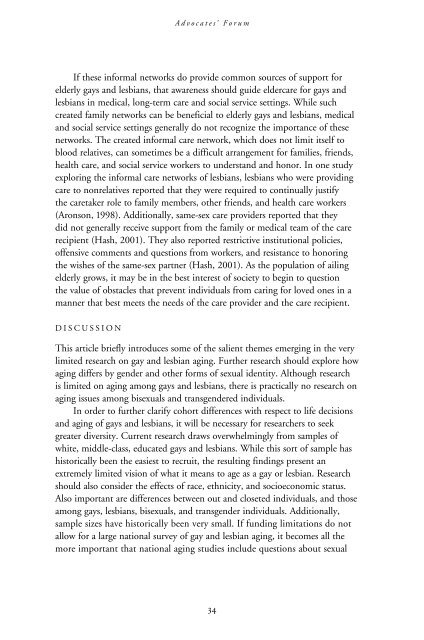2006 - School of Social Service Administration - University of Chicago
2006 - School of Social Service Administration - University of Chicago
2006 - School of Social Service Administration - University of Chicago
You also want an ePaper? Increase the reach of your titles
YUMPU automatically turns print PDFs into web optimized ePapers that Google loves.
Advocates’ Forum<br />
If these informal networks do provide common sources <strong>of</strong> support for<br />
elderly gays and lesbians, that awareness should guide eldercare for gays and<br />
lesbians in medical, long-term care and social service settings. While such<br />
created family networks can be beneficial to elderly gays and lesbians, medical<br />
and social service settings generally do not recognize the importance <strong>of</strong> these<br />
networks. The created informal care network, which does not limit itself to<br />
blood relatives, can sometimes be a difficult arrangement for families, friends,<br />
health care, and social service workers to understand and honor. In one study<br />
exploring the informal care networks <strong>of</strong> lesbians, lesbians who were providing<br />
care to nonrelatives reported that they were required to continually justify<br />
the caretaker role to family members, other friends, and health care workers<br />
(Aronson, 1998). Additionally, same-sex care providers reported that they<br />
did not generally receive support from the family or medical team <strong>of</strong> the care<br />
recipient (Hash, 2001). They also reported restrictive institutional policies,<br />
<strong>of</strong>fensive comments and questions from workers, and resistance to honoring<br />
the wishes <strong>of</strong> the same-sex partner (Hash, 2001). As the population <strong>of</strong> ailing<br />
elderly grows, it may be in the best interest <strong>of</strong> society to begin to question<br />
the value <strong>of</strong> obstacles that prevent individuals from caring for loved ones in a<br />
manner that best meets the needs <strong>of</strong> the care provider and the care recipient.<br />
DISCUSSION<br />
This article briefly introduces some <strong>of</strong> the salient themes emerging in the very<br />
limited research on gay and lesbian aging. Further research should explore how<br />
aging differs by gender and other forms <strong>of</strong> sexual identity. Although research<br />
is limited on aging among gays and lesbians, there is practically no research on<br />
aging issues among bisexuals and transgendered individuals.<br />
In order to further clarify cohort differences with respect to life decisions<br />
and aging <strong>of</strong> gays and lesbians, it will be necessary for researchers to seek<br />
greater diversity. Current research draws overwhelmingly from samples <strong>of</strong><br />
white, middle-class, educated gays and lesbians. While this sort <strong>of</strong> sample has<br />
historically been the easiest to recruit, the resulting findings present an<br />
extremely limited vision <strong>of</strong> what it means to age as a gay or lesbian. Research<br />
should also consider the effects <strong>of</strong> race, ethnicity, and socioeconomic status.<br />
Also important are differences between out and closeted individuals, and those<br />
among gays, lesbians, bisexuals, and transgender individuals. Additionally,<br />
sample sizes have historically been very small. If funding limitations do not<br />
allow for a large national survey <strong>of</strong> gay and lesbian aging, it becomes all the<br />
more important that national aging studies include questions about sexual<br />
34
















